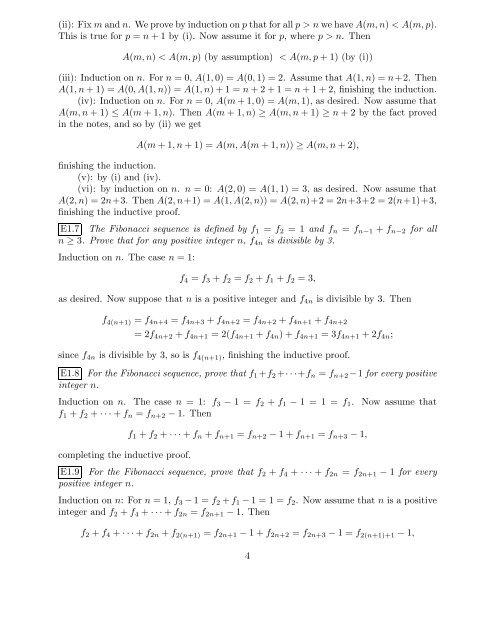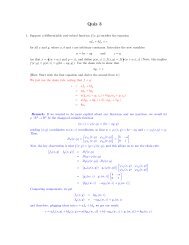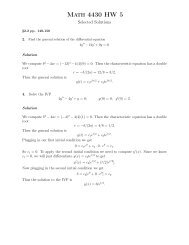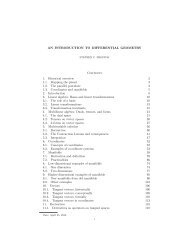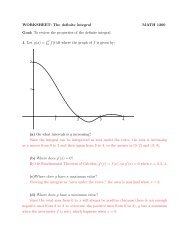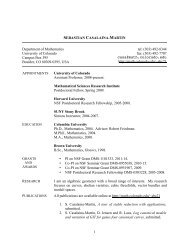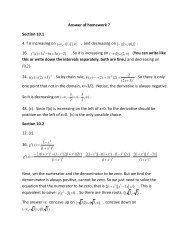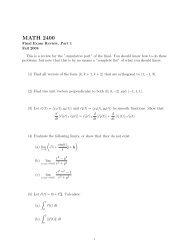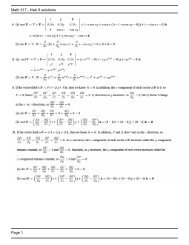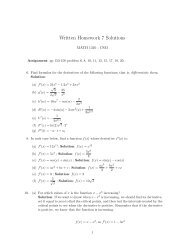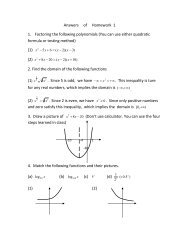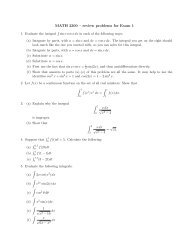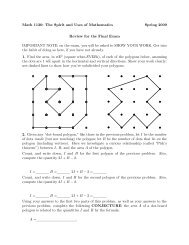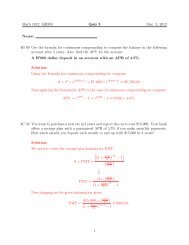Solutions for exercises in chapter 1 E1.1 Prove by induction that for ...
Solutions for exercises in chapter 1 E1.1 Prove by induction that for ...
Solutions for exercises in chapter 1 E1.1 Prove by induction that for ...
Create successful ePaper yourself
Turn your PDF publications into a flip-book with our unique Google optimized e-Paper software.
(ii): Fix m and n. We prove <strong>by</strong> <strong>in</strong>duction on p <strong>that</strong> <strong>for</strong> all p > n we have A(m, n) < A(m, p).<br />
This is true <strong>for</strong> p = n + 1 <strong>by</strong> (i). Now assume it <strong>for</strong> p, where p > n. Then<br />
A(m, n) < A(m, p) (<strong>by</strong> assumption) < A(m, p + 1) (<strong>by</strong> (i))<br />
(iii): Induction on n. For n = 0, A(1, 0) = A(0, 1) = 2. Assume <strong>that</strong> A(1, n) = n+2. Then<br />
A(1, n + 1) = A(0, A(1, n)) = A(1, n) + 1 = n + 2 + 1 = n + 1 + 2, f<strong>in</strong>ish<strong>in</strong>g the <strong>in</strong>duction.<br />
(iv): Induction on n. For n = 0, A(m + 1, 0) = A(m, 1), as desired. Now assume <strong>that</strong><br />
A(m, n + 1) ≤ A(m + 1, n). Then A(m + 1, n) ≥ A(m, n + 1) ≥ n + 2 <strong>by</strong> the fact proved<br />
<strong>in</strong> the notes, and so <strong>by</strong> (ii) we get<br />
A(m + 1, n + 1) = A(m, A(m + 1, n)) ≥ A(m, n + 2),<br />
f<strong>in</strong>ish<strong>in</strong>g the <strong>in</strong>duction.<br />
(v): <strong>by</strong> (i) and (iv).<br />
(vi): <strong>by</strong> <strong>in</strong>duction on n. n = 0: A(2, 0) = A(1, 1) = 3, as desired. Now assume <strong>that</strong><br />
A(2, n) = 2n+3. Then A(2, n+1) = A(1, A(2, n)) = A(2, n)+2 = 2n+3+2 = 2(n+1)+3,<br />
f<strong>in</strong>ish<strong>in</strong>g the <strong>in</strong>ductive proof.<br />
E1.7 The Fibonacci sequence is def<strong>in</strong>ed <strong>by</strong> f1 = f2 = 1 and fn = fn−1 + fn−2 <strong>for</strong> all<br />
n ≥ 3. <strong>Prove</strong> <strong>that</strong> <strong>for</strong> any positive <strong>in</strong>teger n, f4n is divisible <strong>by</strong> 3.<br />
Induction on n. The case n = 1:<br />
f4 = f3 + f2 = f2 + f1 + f2 = 3,<br />
as desired. Now suppose <strong>that</strong> n is a positive <strong>in</strong>teger and f4n is divisible <strong>by</strong> 3. Then<br />
f 4(n+1) = f4n+4 = f4n+3 + f4n+2 = f4n+2 + f4n+1 + f4n+2<br />
= 2f4n+2 + f4n+1 = 2(f4n+1 + f4n) + f4n+1 = 3f4n+1 + 2f4n;<br />
s<strong>in</strong>ce f4n is divisible <strong>by</strong> 3, so is f 4(n+1), f<strong>in</strong>ish<strong>in</strong>g the <strong>in</strong>ductive proof.<br />
E1.8 For the Fibonacci sequence, prove <strong>that</strong> f1+f2+· · ·+fn = fn+2 −1 <strong>for</strong> every positive<br />
<strong>in</strong>teger n.<br />
Induction on n. The case n = 1: f3 − 1 = f2 + f1 − 1 = 1 = f1. Now assume <strong>that</strong><br />
f1 + f2 + · · · + fn = fn+2 − 1. Then<br />
complet<strong>in</strong>g the <strong>in</strong>ductive proof.<br />
f1 + f2 + · · · + fn + fn+1 = fn+2 − 1 + fn+1 = fn+3 − 1,<br />
E1.9 For the Fibonacci sequence, prove <strong>that</strong> f2 + f4 + · · · + f2n = f2n+1 − 1 <strong>for</strong> every<br />
positive <strong>in</strong>teger n.<br />
Induction on n: For n = 1, f3 −1 = f2 +f1 − 1 = 1 = f2. Now assume <strong>that</strong> n is a positive<br />
<strong>in</strong>teger and f2 + f4 + · · · + f2n = f2n+1 − 1. Then<br />
f2 + f4 + · · · + f2n + f 2(n+1) = f2n+1 − 1 + f2n+2 = f2n+3 − 1 = f 2(n+1)+1 − 1,<br />
4


